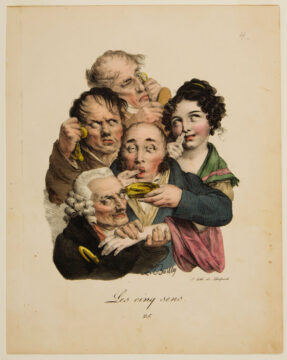by Joseph Shieber

Suppose that you’re sitting at a pristine, white desk and are presented with the following scene (graciously rendered by Google Bard from a description by me):

How would you describe what you see? Maybe something like, On the desk in front of me there’s a medium-sized, shiny green sphere in front of a large, matte red cube.
The process by which you see, however, doesn’t involve the wholesale transmission of information about discrete objects from the environment to your consciousness. Rather, that process involves the decomposition of information into constituent components. Very roughly, the rods and cones in your eyes encode light reflectances from surfaces in your immediate environment into biochemical signals and communicate them, by way of your optic nerve, to your visual cortex, where those signals undergo further processing. Some parts of this process involve distinguishing between light and dark, other parts involve the detection of edges, lines, and orientations, while still other parts involve encoding for color, motion, depth, and object-hood.
The way that this process occurs seems to present a problem. How is it that the discrete pieces of information — shiny, matte, red, green, sphere, cube, in front, behind, etc. — get put back together in the right way when that information eventually makes its way to your consciousness? Given the scene on your desk and the process by which your sense organs and brain process that visual information of the scene, why do you become aware of the right collection of properties – the green, shininess, and spherical shape belonging to the object in front, and the red, matte surface, and cubic shape belonging to the object behind? In fact, why are the properties even connected at all in your consciousness, rather than appearing as separate impressions of color, shape, surface, etc.?
This puzzle of how it is that the visual properties that we sense are “bound” together into experiences of objects is one version of the “binding problem” in neuroscience. Merely one version, because we can easily imagine others. To take just one further example, when you then reach out your hand to grasp the object in front on your desk, why do you register your tactile experiences as belonging to the same green, spherical object that you see?
Though the binding problem is still a live problem in 21st century neuroscience, it was actually anticipated more than 2000 years ago, in the Nyāya Sutras (Sutras 3.3.1-14). There, the author of the Sutras uses what is basically the binding problem to argue against the idea that the self might consist in nothing more than a collection of all of the component parts of the living human body. This latter, materialist, view was defended by the Cārvāka school, one of the rival schools of the Nyāya.
According to the Cārvāka school, consciousness is nothing more than a product of certain physical structures interacting together in a particular way. Though much of our knowledge of the Cārvāka school comes from critiques of the school by their critics, one of the analogies that the Cārvāka themselves apparently employed to explain the production of consciousness from interactions of matter is that of wine’s intoxicating property emerging from the mixture of material elements during fermentation.
One statement of this comes from the Sarva-darsana-samgraha of Madhava Acharya, a 14th century Advaita Vedanta philosopher. In critiquing the Cārvāka position, Madhava attributed the fermentation analogy to them, describing them as believing that, “from [the four elements] alone, when transformed into the body, intelligence is produced, just as the inebriating power is developed from the mixture of certain ingredients”
In other words, the elements of the body give rise to consciousness, according to the Cārvāka, much as yeasts convert carbohydrate into ethanol. There is no need for anything extra like an immaterial soul.
Philosophers of the Nyāya school rejected materialism, believing there to be an immaterial soul that was the substrate of consciousness. Their main reason for this was, essentially, the binding problem: they didn’t see how disparate sense organs could produce the unified experiences that characterize our consciousness.
For example, in 3.1.1 of the Nyāya Sutra, we see the argument that consciousness cannot simply be the produce of a sense organ, because “we can apprehend [one and the same] object through both sight and touch.”
In other words, if consciousness were nothing more than the result of an aggregation of body parts, then perception could not occur as a unified event. When I perceive an object like a pot, it is experienced as a single, unified pot. But if my self were really just an assemblage of body parts like hands, feet, eyes, etc., then each body part would perceive only a fragment or aspect of the pot.
Further, at 3.1.7, the text argues that consciousness must be over and above the sense organs, “because what is seen by the left eye is recognized by the right.” The idea seems to be that if there were nothing over and above my conscious perception that the action of my sense organs then my two eyes, being two distinct organs, would each perceive at best distinct pots. There would be no unification or coordination of these fragmented perceptions into the experience of a whole pot.
So given that in reality, perception does occur as a unified event with objects appearing as integrated wholes, the Nyāya argue that there must be an underlying perceiver – a self – that accounts for this unity. This self which unifies diverse sensory experiences cannot itself just be a random bundle of body parts and sensory organs. There must be a distinct, unitary entity that oversees and combines the sensory impressions coming from different parts of the body to generate a meaningful, coherent experience of objects.
This is why the Nyāya take the Carvaka view to be incorrect – the self is not the same thing as the body or its parts. There must, on the Nyāya view, be an independent, non-physical self that organizes and unifies bodily perceptions into a single, seamless experience of reality.
My point here isn’t to endorse the Nyāya rejection of materialism in favor of an immaterial soul, nor to endorse the Nyāya implication that the binding problem entails that materialism is unworkable — indeed, I reject both of these claims. Rather, it’s simply to marvel at the fact that around 200 B.C.E. — more than 2000 years ago! — these thinkers anticipated a problem that still plagues contemporary neuroscience … and indeed discussed that problem with an impressively high level of sophistication.
(Some of these ideas might have been floating around even earlier than the Nyaya discussion. Fragment 88 of Empedocles, “One vision is produced by both the eyes,” suggests that Empedocles, who lived in the 400s B.C.E., might also have had the binding problem in mind. However, the discussion in the Nyāya Sutras is a far more explicit and sophisticated treatment of the problem than what we find in Empedocles.)
Actually, my goal is not merely to marvel at the richness of the Nyāya discussion. It’s also to lament that so few students — even philosophy students — receive any introduction to that richness. Until about a decade ago, even my introductory philosophy courses only drew from the so-called “western” philosophical tradition, with no mention of India, China, the Arabic tradition, or Africa — this despite the fact that, during my grad school years at Brown, I taught a continuing education course on philosophical traditions in classical India.
About a decade ago I redesigned my introductory course in philosophy so that it includes at least a smattering of the traditions of India, China, Arabic philosophy, and African philosophy. Now, when I revisit so many of these marvelous texts, I can’t help but feel that students who only encounter the “classics” of Plato, Aristotle, Descartes, Locke, Hume, and Kant -– wonderful as those philosophers are! — are missing out on a whole world of philosophical debate. The Nyāya anticipation of the binding problem is only one example, the merest glimpse of that wider world.
